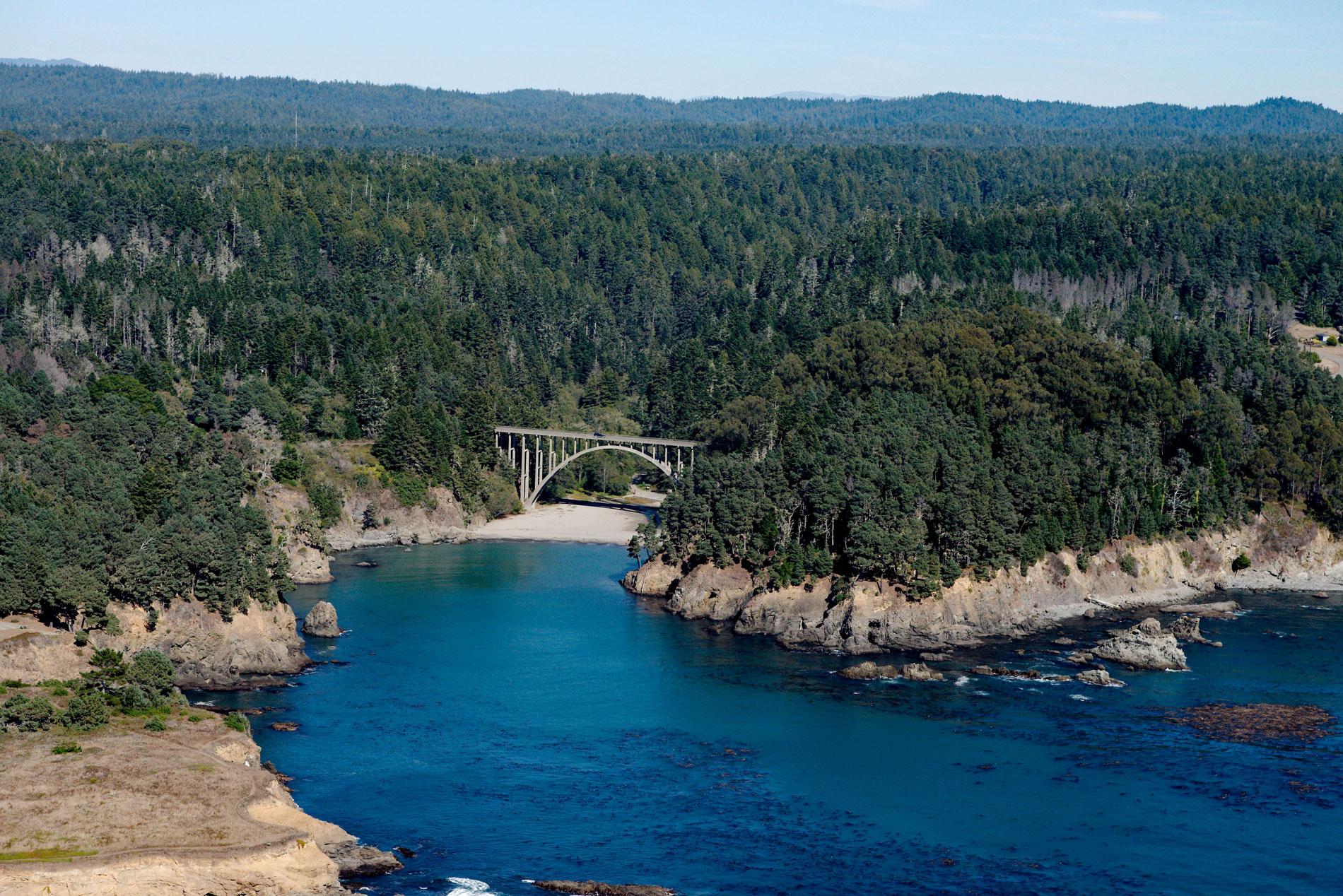Russian Gulch is a river that starts at an elevation of about 800 feet (244 m) on the northwestern flank of Hi Chute Ridge in the California Coast Ranges and flows generally northwest for 5 miles (8 km) to the Pacific Ocean, draining a watershed of 2,456 acres (994 ha) in Russian Gulch State Park, about 2 miles (3.3 km) north of Mendocino and 7 miles (11 km) south of Fort Bragg, California. The name was reputedly given to the area by U.S. government surveyors in honor of the Russian fur traders who founded Fort Ross 50 miles (81 km) to the south. The Russian Gulch watershed is formed by bedrock representing the Franciscan Complex and the river has eroded through marine terraces near the mouth creating a deep ravine. The Franciscan Complex developed during the Mesozoic and is dominated by greywacke sandstones, shales and conglomerates which have experienced low-grade metamorphism. A series of marine terraces developed during the Pleistocene as the climate fluctuated and sea levels rose and fell in conjunction with the advance and retreat of continental glaciers. Wave erosion cut platforms in the rocky shoreline which were subsequently submerged when sea levels rose. The submerged platforms were gradually covered by gravel, sand, and silt sediments deposited at different depths. Subsequent tectonic uplift then slowly elevated the terraces above sea level and each developed a unique soil type and plant community.
Russian Gulch is part of the traditional territory of the Pomo people who have inhabited the Mendocino coast for about 3,000 years. They built redwood bark houses at the mouths of rivers and hunted large and small game, caught fish and shellfish, and gathered seaweed, acorns, and various seeds. Whatever they could not obtain locally, they acquired in trade with neighboring tribal groups. The first Europeans to make contact with the Pomo were probably Russian fur traders in the early 1800s, followed in the 1830s by American and Hudson’s Bay Company trappers. In 1848, the discovery of gold in the Sierra Nevada foothills triggered a demand for lumber. With fortunes in gold coming out of the placer mines, lumber was needed to provide timbers for mines and ties for the railroads. Early logging was conducted with hand tools and ox teams. Splash dams were erected on the coastal rivers and creeks to store logs until enough water built up to float them downstream to sawmills. The milled lumber was then loaded onto schooners with intricately designed and constructed lumber chutes. The steam engine was first employed by the logging industry, first as a means of handling logs on steep hillsides and later as a means of transporting lumber with narrow-gauge railroads. In the late 19th century, there were hundreds of small rural sawmills between Central California and Southern Oregon. Ports like Russian Gulch were commonly called dog hole ports from the notion that they were barely big enough for a dog to turn around. Coastal schooners would make dangerous stops in these coves to take on redwood lumber and passengers. At Russian Gulch, iron rings were bolted to the headland and used to secure mooring lines when ships were being loaded with lumber.
Lumber operations around Russian Gulch were modest, mostly producing shingles, split lumber, and railroad ties. In 1867, one of the first redwood shingle mills in California was built here by L.E. Ballister & Co. In 1933, the state acquired the land for Russian Gulch State Park. In 1940, a concrete arch bridge was constructed spanning Russian Gulch for California State Highway 1. In 1999, the Marine Life Protection Act was signed into state law requiring California to design and manage a network of marine reserves and other protected areas to protect threatened ecosystems. In 2004, the California Natural Resources Agency used state and private funding to launch the Marine Life Protection Act Initiative, which during its first phase, implemented the Act along the central coast of California. In 2012, Russian Gulch State Marine Conservation Area was established from the land boundary with Russian Gulch State Park to a depth of 15 feet (4.6 m) offshore. This is one of 124 marine protected areas in California to protect the rocky seafloor and kelp forest habitat important for abalone, crabs, oysters, and nearshore fish, especially cabezon, greenling, lingcod, and perch. Russian Gulch State Marine Conservation Area expanded on a smaller, previously established marine protected area at this location, and provides essentially the same protections except that harvesting bull kelp and giant kelp is prohibited. Read more here and here. Explore more of Russian Gulch and the Mendocino coast here:

